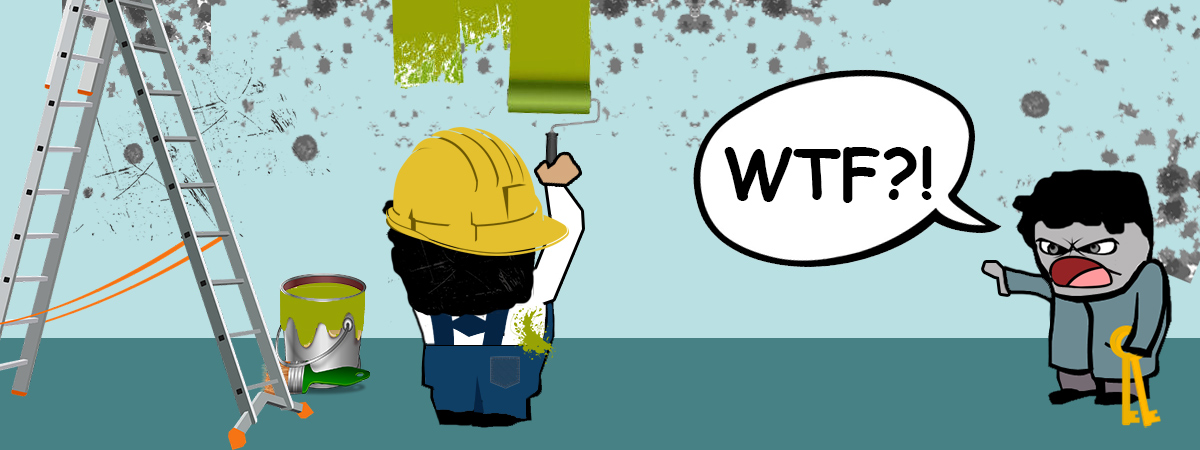
Yup, my knuckle-head tenants (bless their silly cotton socks) – went and did “it”!
They never bothered to notify me, their landlord, of a mould outbreak, and decided to take matters into their own hands by applying the least effective means of treating mould on the planet (presumably thinking it was a smart (and safe) idea).
If you’re considering painting directly over mould as a form of treatment… PLEASE, FOR THE LOVE OF GOD, DON’T DO IT!

The tale of two idiots painting over mould
Seems like many blue Moons ago now, but it was only a month or so ago, when I was shaking my fists in the air having witnessed the horrific conditions my tenants chose to live in.
During my hissyfit, I briefly mentioned that the pair of numpties had obviously painted over mould in the bathroom, days before vacating the property, presumably as a futile attempt to mask the problem.
Evidently, my tenants didn’t do a very good job because I spotted the ploy almost immediately. The Chuckle Brothers only painted over the areas that were infested with mould, while leaving the rest of the walls untouched, consequently I was left with walls covered in 2 very different shades of white. It didn’t take a rocket scientist to work out something wasn’t quite right.
I’m actually not sure if they tried to mask the problem so I wouldn’t notice or because they thought the paint would kill the mould. Either way, there was no need to question their intelligence because it was clear they had a very limited supply between them. I was, however, left questioning their sanity. I probably had a moral obligation to report them to some kind of institute for dumb assholes.
I’m also not sure whose brainchild it was to limit the paint to the areas saturated in mould, but they should both equally be punished, in this life or the next, because while one was committing the dumbest act of the century, the other allowed it to happen.
Mould doesn’t just miraculously cover large surface areas overnight; it enrolls onto a learning & development program and slowly blossoms. And much like an infected penis, you need to nip the problem in the bud as soon as possible, otherwise things turn green and shit starts to flake off. Nasty stuff.
What many people don’t realise is that mould is a type of fungus, which can cause serious health risks, so it needs to be treated properly, and preferably not covered up with a lick of paint. What they did was actually extremely dangerous/stupid. Not to mention, mould will slice through fresh paint like a knife cutting through warm butter.
The infestation wasn’t exactly inconspicuous; it had reached the dark black/brown stage. Meanwhile, my tenants managed to blissfully turn a blind eye to the prominent shit-coloured stains splattered all over the white walls and carry on living their ghastly unsanitary day-to-day lives. Lovely.
It’s mostly frustrating because I provided them with a clean property, and the bathroom specifically had an extractor fan (which I’m assuming they never used because it had an isolated switch which wasn’t connected to the light switch) and it didn’t have any history of mould from previous tenants. Moreover, if they had the sense and courtesy to report the problem, I would have attended to the issue immediately. But for some obscure and unknown reason, they felt compelled to remain mute and revel in the filth. Perhaps that’s their fetish, to live in challenging environments that could ultimately cause ill health.
Alas, these people are just filthy bastards by nature, and probably dig into their underwear when requiring cheese to assist their crackers.
The reason I’m going over this hideous incident again is because I want to cover the topic of mould in greater depth since it is a big issue in rented property. But also, I was frantically Googling for specific resources on “how to remove mould from under fresh paint” with very little luck. There were, however, plenty of resources available on how to remove mould from the surface. But that was no good to me.
Incidentally, apparently the best way is to scrub it off with regular household bleach. But bear in mind, that may not prevent it from occurring again. You need to find the root of the problem and destroy it. Of course, the root of the problem could just be mentally retarded tenants that don’t like upholding basic human hygiene standards.
I hadn’t had much experience with mould in the past, but I could tell that the infestation in the bathroom wasn’t extreme and didn’t require professional help. The only assistance I received was from the comments I read in various forums. I managed to bastardise several tips and produce my own cure (nothing revolutionary, mind you)…
My experience: how I removed mould that was painted over!
1) Diagnose
The first thing I did was scrape off a small area of the top coat of paint so I could get a closer look and diagnose the diarrhea stains that were gobbling up the walls. I had to be sure it was mould before treating it with anti-mould remedies.
Fortunately, in my case, it was pretty obvious I was dealing with mould… because it looked all moudly and stuff. Good technical diagnosis from me there.
Apparently mould commonly gets confused with dirt (really?). I read that the best way to distinguish between mould and dirt is to apply bleach to the area. If the brown stains lighten then it’s most likely mould, because bleach won’t change the colour of dirt. I’m not sure how true that is, but it seemed to be the general consensus among the forum contributors. Either way, I bypassed the bleach test, I just went with my unqualified gut-instinct and my lifetime experience of never dealing with mould. But come on, mould looks like mould! It was definitely mould!
Annoyingly, I forgot to take a ‘before picture’, so I can’t show you the ridiculous state the walls were left by my rat-weasel tenants, so you’ll have to use your imagination. Just imagine bathroom walls sporadically covered in two different shades of white, kind of like a patchwork quilt effect. Now picture me, an unbelievably handsome chap, which has enough sexual prowess to rival a Silverback gorilla, standing there naked, pointing into the suspect areas that had been freshly painted. In reality, I wouldn’t need to be standing there naked, pointing out the mismatching tones, because it was clear as day, but I’m just there for your pleasure.
2) Cleaning the surface
The aim at this stage was to clean the surface from dirt and rub away as much of the fresh emulsion as possible. I wiped the area down with warm soap water. Surprisingly, the newest layer of paint came off effortlessly. Believe it or not, but mould isn’t the most effective adhesive primer. Go figure.
Having rubbed off the majority of the top coat of paint, it soon became clear what I was dealing with. This is what my tenants had painted over:

Allow me to reiterate: they lived with that infestation starring them square in the face, every damn day. The irony is, that’s in the corner of the bathroom; a room dedicated to control and maintain human hygiene. My tenant, the unsterile buffoon, cleaned his penis and other unsavoury body parts with that looking at him in the face. How can he live with himself? Shameful.
3) Stripping the paint
Now that I had exposed the mould to the surface, I could have started scrubbing the area with bleach, and that’s exactly what most people advised in the forums. But I wanted to be more thorough than that, and I’ll explain why…
The dangerous (and envious) quality about mould is that it can fuck with itself. It doesn’t need a partner to reproduce, so a single survivor can rebuild a city. Moreover, mould can get into and under the paint, so even if I scrub and kill the mould on the surface, it wouldn’t necessarily resolve the problem because the infestation could be rooted deeper.
Ensuring that I was removing all the mould was my main objective; the last thing I wanted was to receive a phone call a few months down the line from my new tenants telling me there’s a mould outbreak, and consequently their vital organs were in the process of shutting down one-by-one. I don’t think I would be mentally strong enough to deal with that!
So this step was all about sparing my sanity by stripping off the old paint, down to the bone. This would allow me to check if the mould managed to penetrate down to the walls or under the paint. But more importantly, it would ensure the mould was being physically removed from the wall, and not just killed with a liquid solution.
Scraping off the paint with a handheld scraper would have taken a lifetime, and I would have most likely damaged my sanity and the walls by taking out huge chunks of plaster due to frustration and fatigue. Instead, I went to B&Q and purchased two bottles of paint remover. If my memory serves me correctly, it set me back £7.
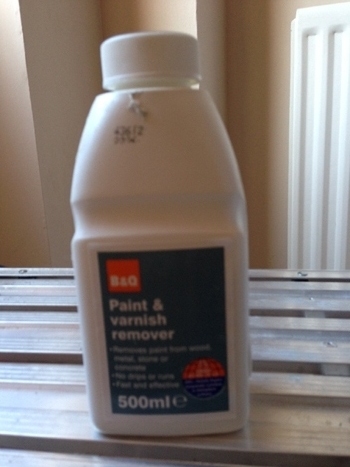
I poured the solution into a paint tray and applied it very generously over the infected areas. I let it settle for 30mins so it could eat away at the paint and transform into a gooey paste. At this point, it was surprisingly easy to lightly scrape/rub off the old paint; it was like tender meat falling off a bone. I didn’t strip the entire bathroom, only the areas that had been covered in mould and a bit more (to be safe).
Below is a picture of the end result. It was a relatively painless experience, even though it probably looks labour intensive.
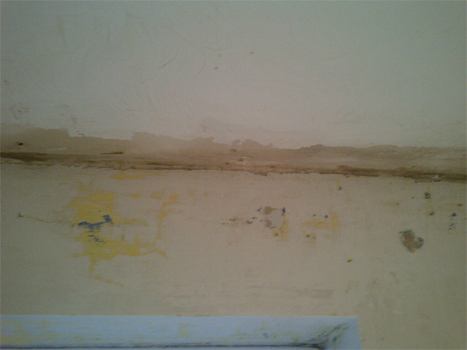
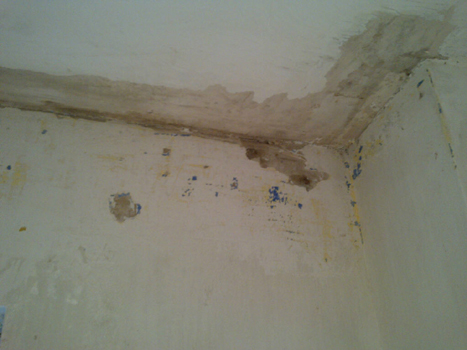
Now that I’ve proved I can be heroic and masculine, let’s move on…
As you can see, the mould hadn’t penetrated the walls, it only managed to attack the paint, which was a massive relief.
4) Wiping down
Having stripped off all the paint, I then aggressively wiped down the areas with a wet sponge. This played two important roles; firstly, it removed the remains of the gooey residue that had formed, but most importantly, it removed the paint stripper solution from the wall. That’s crucial, otherwise I would have had a soul-destroying episode trying to reapply paint on top of paint-stripper. It would not have worked, you know, kind of like painting over freaking mould.
5) Anti-mould solution
At this stage, the walls looked mould free. But I wanted to be extra cautious, so I purchased a bottle of Polycell Mould Remover Spray (approx £10.00) from my local DIY joint, and then generously sprayed it in and around the – hopefully – former infected areas.
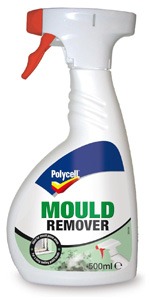
There are plenty of mould solutions available, so pick your poison. Word of caution, make sure to get a mould “killer/remover” if you want to remove mould, and not just a mould stain remover.
Polycell Mould Remover Spray seemed to work for me (I think anyways), so make of that what you will. It’s widely available from local supermarkets and DIY stores, but it’s also from online retailers. Obvs it’s available on Amazon (affiliate link).
6) Anti-mould paint
Two days later I examined the area; the walls were stripped down, there wasn’t any sign of mould, and the walls were dry. The area had completely recovered and was ready for a new coat of paint.
In the past I’ve always used the same regular emulsion to paint every room in a property, but after this experience (my first experience with mould), I decided to pay the premium price for anti-mould emulsion. It’s more expensive than regular emulsion, but if you calculate the amount of time and money it could save you from combating against mould, it’s a no-brainer. I’m going to apply anti-mould emulsion in all bathrooms and kitchens I paint from now on.
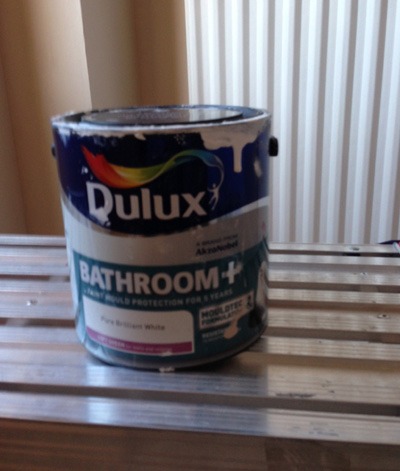
For those curious, this is what the bathroom looks like now it’s been disinfected from my previous tenants funk…

The severity of mould infestations vary drastically, so I can’t guarantee my solution will work for every case. In fact, I know it won’t. But it worked for me. Here’s a website which covers a whole array of easy-to-follow home remedies for removing lighter cases of mould in the home.
If you’re struggling or feel like you’re out of your depth, it’s imperative you seek professional help immediately.
How to prevent mould in rental properties (because prevention is cure)
It goes without saying that the best way to cure mould is to prevent it from developing in the first place.
If a landlord provides a tenant with a structurally sound, clean and mould free property, then they’re at the mercy of the tenant, and it’s up to them to act responsibly and prevent mould and dampness from occurring. However, there are a few steps landlords can take to reduce the chances of an outbreak (I now adhere to most of the following steps in all my rentals):
- First and foremost (and most crucially), avoiding filthy and utterly stupid tenants is key. This can be done by thorough tenant referencing e.g. get references from previous landlords.
I also recommend 6 month tenancy agreements (the minimum amount allowed) and then allowing it to roll onto a periodic tenancy, so if there is any negligence from the tenant, you have the ability to take any necessary actions ASAP.
- Use mold resistant products like the anti-mould paint, especially in high-risk areas like kitchens and bathrooms.
Alternatively, I recently came across an Anti-Mould Additive on Amazon (affiliate link), which looks like a pretty cool solution. To be honest, I probably would have used this over the anti-mould paint if I knew about it sooner.
You basically mix the solution into any ol’ regular paint and it apparently prevents mould and the recurrence of it. It’s cheaper than off-the-shelf anti-mould paint (but does the same thing) and lasts for at least 5 years.
(if anyone tries this solution, please let me know how you get on!)
- Install an extractor fan in the bathroom which activates when the bathroom light is switched on. Also, an extractor fan in the kitchen, above the cooker.
- Allow extractor fans to overrun for 20mins once they’re switched off. This is a common feature in most modern extractors.
- Ensure gutters get cleaned and serviced regularly, especially if the property is close to tall trees.
- Don’t provide the property with any indoor plants. The moist soil in indoor plants is a perfect breeding ground for mould, which may then spread to other areas of the house.
- Check that there are no leaks in the property before, during and after each let. Goes without saying regular landlord inspections are crucial to help keep your property in order.
- Even if you see the slightest sign of mould, remove it immediately, and ensure every last speckle is terminated. Many people make the mistake of leaving traces of mould behind, and then wonder why it keeps resurfacing. If you don’t kill/remove it ALL, mould spores will just continue to grow/spread.
- Don’t rent out a property that is infested with mould- cure the problem first! I’m not sure how tried and tested it is, but if a tenant becomes ill due to the landlord’s negligence, it could end up costly.
- If the property is naturally warm and damp for whatever reason, you could provide the property with a humidifier.
- Tiles are a lot more resistant to mould than plasterboard/walls, so it seems to be the safer option in comparison to paint. Although, grouting seems to extract mould pretty easily, but at least that’s easier to clean than paint- you can also get anti-mould grout!
- A costly option is to install a PIV loft unit (e.g. Environment or Nuaire Drimaster). It constantly pushes dry air from the loft into the house, raising the pressure slightly and forcing out the damp air so that the humidity is reduced to a level where mould doesn’t form. It might be a step worth taking if your property severely struggles with dampness.
Who’s responsible for mould, landlord or tenant?
In most cases, when mould is discovered in a rented property, both landlord and tenant frantically try to determine who is responsible, while pointing at one another.
It can be a difficult question to answer and it usually depends on what is causing the problem. For more information, you may want to head over to the Who Is Responsible For Mould- Tenant Or Landlord? blog post.
But ultimately, finding the cause and treating it is what’s most important. If a tenant complains about dampness or mould, don’t just play the blame game and leave it unresolved. Try to work together in order to resolve the problem quickly and efficiently, even if that means spending a little bit of money.
Has anyone else had any experience with mould? Can anyone provide any further tips? Let’s go…
Disclaimer: I'm just a landlord blogger; I'm 100% not qualified to give legal or financial advice. I'm a doofus. Any information I share is my unqualified opinion, and should never be construed as professional legal or financial advice. You should definitely get advice from a qualified professional for any legal or financial matters. For more information, please read my full disclaimer.


 Landlord Products / Services
Landlord Products / Services












All I can say is that I have had such a good laugh of the comments left on this site, glad to see so many people with a sense of humour.